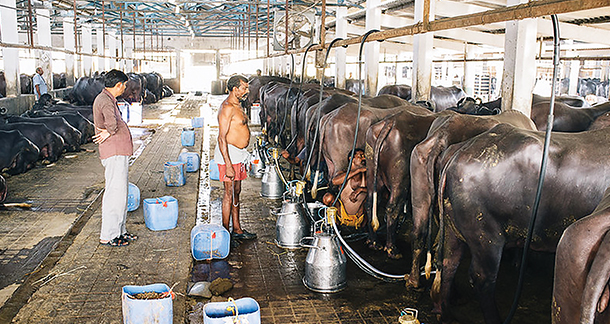This article is authored by Dr AY Rajendra, CEO, Animal & Aqua Feed Business, Godrej Agrovet Limited.

India’s dairy farmers, already struggling with low productivity, now face a growing threat: Heat-stressed cattle.
As the world’s largest milk producer, India accounts for nearly a quarter of global supply. However, inadequate nutrition and poor animal health keep its per capita milk yields at just 1,700–2,000 litres annually, well below the global average of 2,500–3,000 litres.
Heat stress, which has risen by 30% over the past 40 years due to global warming, threatens to worsen this gap. Prolonged heatwaves and hotter summers could decimate India’s dairy sector, undoing the gains of the White Revolution that turned the nation from milk deficient to a milk surplus.
Global warming, the primary driver of heat stress, is accelerating and demands urgent attention to protect India’s dairy industry.
The soaring temperatures are taking a toll on the country’s cattle herds, impacting their health, wellbeing and capacity to produce milk. With temperatures only set to get hotter, forecasts predict that India, as things stand, is set to lose a significant amount of its milk production over the medium to longer term.
A report in the Lancet medical journal, for instance, estimates that heat stress could reduce milk production by as much as a quarter by 2085, destroying the livelihoods of as many as 89 million smallholder dairy farmers. This could escalate to an alarming 45% decline in India’s milk production by century’s end.
Looking ahead to a much nearer future, heat stress could skim 3.4 lakh tonnes off milk production by 2030 in the northern plains alone, translating to roughly ₹15,000 crore in losses for the region’s dairy farmers.
Regions across the country, from Maharashtra and Madhya Pradesh to Bihar, Jharkhand and Tamil Nadu are already reporting declines in milk production.
Their impact goes beyond just the financial hit from production losses. Farmers, for instance, will have to invest in cooling equipment and more frequent veterinary check-ups to treat animals affected by the heat. This will drive up the cost of milk production, in turn pushing up milk prices for the consumer.
But how do you address something as sweeping as global warming? You don’t.
The dairy industry cannot directly influence the trajectory of global warming or the climate crisis, in the same way that it can address the nutrition and animal health challenges.
It must, therefore, adapt animal husbandry and rearing practices to make cattle resilient to rising temperatures and mitigate their impact on milk production.
Farmers will have to build new well-ventilated barns, fitted with a sprinkler system for example, to give animals a reprieve from the heat when they are indoors.
Ensuring easy access to clean, cool drinking water can play a crucial role in regulating cattle body temperatures. Farmers must be provided with support for water storage solutions, shaded troughs, and cooling systems that prevent water from heating up under direct sunlight.
Nutrition and feeding schedules can also be calibrated to build the resilience of animals to the heat. Cattle can be fed high-quality feeds like total mixed rations and more fresh feed.
Nutrition and feeding schedules can also be calibrated to build the resilience of animals to the heat. Cattle can be fed high-quality feeds like total mixed rations and more fresh feed.
Supplements such as electrolytes, vitamins (particularly A, D, and E), and minerals like zinc and selenium also play a crucial role their consumption can improve heat tolerance, boost immune response, and reduce oxidative stress. These supplements can help maintain milk production and animal fertility, even during extended periods of high temperatures.
The frequency of feeding can also be increased with feeds scheduled for cooler times of the day. Farmers can also feed their animals high-quality forage and fibre, or turn to hydroponics to grow high quality feed all year round. They can additionally use bypass proteins to enhance the yield and protein content of the milk.
Read More: Get more News from Dairy Sector
The government is already setting an example when it comes to heat-stress mitigating practices.
It has established demonstration plots in 121 climate-vulnerable districts through its Krishi Vigyan Kendra (KVK) network to showcase climate-resilient practices, ranging from the building of custom-designed shelters to feed supplementation strategies.
But what’s really needed is a wide-ranging approach spanning advisory services, financial incentives and insurance packages. Drawing inspiration from Europe’s Heat Stress Protect programme, which addresses a wide range of economic losses, India could establish a framework to support farmers holistically.
As a nation that transformed itself from milk deficient to a milk surplus giant – producing 210 million tonnes annually – India cannot afford to falter. By acting now, it can build resilience, protect livelihoods, and secure its dairy sector’s future against the growing threat of heat stress.
Join Our “Dairy & Food Jobs Updates” WhatsApp group
Stay informed on all the latest news updates
All Agriculture Books Free Download
All Dairy Technology Books Free Download
All Agricultural Engineering Books Free download
All Horticulture Books Free Download
All Fisheries Science Books Free Download
For Daily Update follow us at:
Facebook Telegram Whatsapp Instagram YouTube
The contents are provided free for noncommercial purpose such as teaching, training, research, extension and self learning.
If you are facing any Problem than fill form Contact Us
If you want share any article related Agriculture with us than send at info@agrimoon.com with your contact detail.


